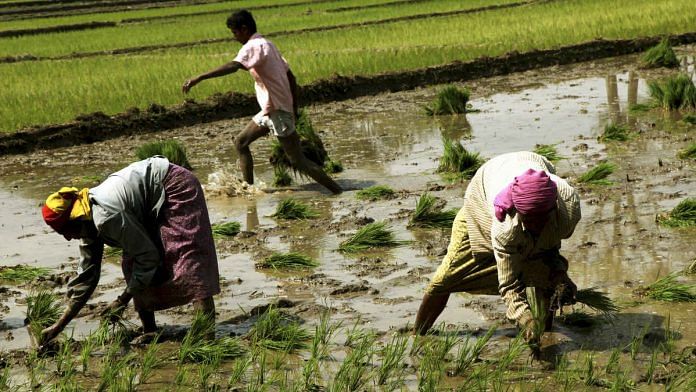New Delhi: The Narendra Modi government managed to transfer funds to nearly one crore beneficiaries under the Pradhan Mantri Kisan Samman Nidhi (PM-Kisan) scheme on 24 February, a little over three weeks after it was first announced in the budget, and within a week of first receiving data from the states.
The government has since transferred funds to another one crore beneficiaries, but achieving the target of 12 crore beneficiaries by the end of March remains a challenge.
Inadequate land records, lack of Aadhaar coverage in some states, as well as non-cooperative state governments in some opposition-ruled states like West Bengal are some of the challenges the scheme faces.
Finance Minister Arun Jaitley tweeted about the scheme and its roadblocks Thursday.
Union Government has released the first instalment of Rs.2000 to
more than 2 crore small and marginal farmers under #PM-KISAN Scheme within 11 days of the launch of the scheme.
— Arun Jaitley (@arunjaitley) March 7, 2019
However, the spread of beneficiaries is very uneven across states. Why are some Congress ruled states and West Bengal not co-operating with PM-Kisan? Why are they letting down their farmers?
— Arun Jaitley (@arunjaitley) March 7, 2019
Total number of small and marginal Farmers forwarded by some states are as follows: pic.twitter.com/lLk3hXDDxQ
— Arun Jaitley (@arunjaitley) March 7, 2019
PM-Kisan was announced in this year’s interim budget as the Modi government made its final attempt to appease farmers — a politically-crucial electoral base.
Under this scheme, small and marginal farmers with holdings up to two hectares will get a direct income support of Rs 6,000 annually in three equal instalments. The government estimated that 12 crore farmer families would benefit from the scheme, and announced it would be implemented retrospectively from 1 December 2018.
UP leads the way
So far, the central government has managed to deposit Rs 2,000 each in the bank accounts of around 2 crore farmers. It used beneficiary names provided by some fast-moving states like Uttar Pradesh, and used the technology under the existing public finance management system (PFMS) to make the transfers directly into the bank accounts of the beneficiaries.
Of the one crore beneficiaries to receive the first instalment on 24 February, 40 lakh were from Uttar Pradesh.
“Some states have been very quick in providing the beneficiary details. We started getting the beneficiary data from the states from 16 February onwards. UP, Gujarat, Punjab, Haryana, Maharashtra, Tamil Nadu, Andhra Pradesh and Telengana have been very quick,” said an agriculture ministry official who did not wish to be identified.
“Rajasthan, Madhya Pradesh and Chhattisgarh have been laggards. West Bengal has not provided any names.”
Many states have existing databases on land records, which they use to transfer funds to farmers under their schemes or during natural calamities like droughts or floods.
“Another challenge is the lack of preparedness in certain states. For instance, in the Northeast, land ownership is an issue. Bihar and Jharkhand have a problem with their land records. They have to be updated or some alternative way of finding the beneficiaries has to be found,” the official added.
The fact that Aadhaar coverage is not saturated in states like Assam is also posing a problem.
Also read: Loan waiver a bad idea, but PM-Kisan will help farmers in real need: CEA K.V. Subramanian
The process
At present, a three-step verification process is followed by the Centre.
States send the data to the PM-Kisan portal, where the Aadhaar number and other requisite details are checked. The data is then transferred to the Public Financial Management System, where the bank account details and the IFSC code are checked. This data then goes to the banks, who check if the registered bank account holder name matches with the beneficiary name.
At the time of providing the beneficiary details, states also have to ensure that the database is in conformity with the exclusion list put out by the centre. As per the central government’s exclusion list, the benefits of the scheme will not be available to practicing professionals, government employees, MPs or MLAs, or public functionaries.
Going forward, the government hopes to transfer money using Aadhaar-linked bank accounts for all states, by the time it releases funds in August. It is also nudging states with inadequate land records to look for alternative means of identifying beneficiaries under the PM-Kisan scheme, as it struggles to reach the intended beneficiaries in the next few weeks.
Also read: India’s growth not leading to jobs, farm loan waivers don’t help poor – Raghuram Rajan




And the same government does not have money to pay salaries at TIFR. Has been cutting down grants at institutes for higher education. Has money to spend on add featuring the great achievements of the PM, with big photographs – 3 to 4 pages in a day in all major newspapers. PM has money to travel to every part of the country on official work and combine it with party work (BJP Rallies). Self-promotion to win elections and pretending to help the farmers (while it is no more than attempt to bribe using public money) is key to governance. Why did the government not wake up to help the farmers after 2 consecutive droughts or ensure that farmers get a fair price for their produce? Why distribute money without knowing if it is going to the right person in the election year?
Is it what we mean by minimum government, maximum governance?